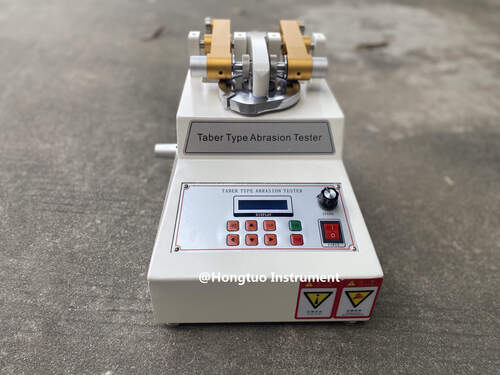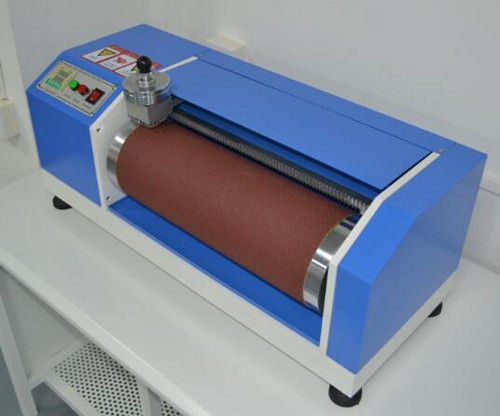
Abrasion Testing Equipment Taber Abrasion Tester
Product Details:
- Application Surface abrasion resistance testing for paints, coatings, plastics, textiles, leathers, etc.
- Mounting Type Benchtop
- Test Range 0-999,999 cycles
- Accuracy 1 rotation
- Automation Grade Semi-automatic
- Resolution 1 cycle
- Power Supply 220V AC 10%, 50Hz
- Click to view more
Abrasion Testing Equipment Taber Abrasion Tester Price And Quantity
- 1 Set
- 999.00 - 1999.00 USD ($)
Abrasion Testing Equipment Taber Abrasion Tester Product Specifications
- 220V AC 10%, 50Hz
- Standard control panel, optional USB/RS232
- 1 specimen per test
- 0-999,999 cycles
- Benchtop
- 1 rotation
- Approx. 24 kg
- Surface abrasion resistance testing for paints, coatings, plastics, textiles, leathers, etc.
- 1 cycle
- Semi-automatic
- 60 / 72 rpm
- Digital LCD display
- Variable, programmable
- Real-time
- Abrasion wheels: 250g, 500g, 1000g (optional)
- Specimen height up to 12.7 mm
- Typical test width: 100 mm (standard specimen size)
- Programmable cycles, interchangeable abrading wheels, dust cover, automatic stop
- Use with standard calibrated abrading wheels
- Standard sample holder: 100 mm
- Ambient or as per test standard (10C to 40C recommended)
- Laboratory, quality control, research
- Digital Control / Manual Control
- Ambient or as per test standard (20-90%RH recommended)
- 50 Hz
- 0 to 999,999 rotations
- 220V AC
- Abrasion Testing Equipment
- Outer diameter 100 0.2 mm, Inner diameter 6.35 to 8.25 mm, Thickness 2-12.7 mm
Abrasion Testing Equipment Taber Abrasion Tester Trade Information
- shenzhen
- 300 Set Per Month
- 7 Days
- Standard exporting wooden package
- All India
- CE FCC
Product Description
Abrasion Testing Equipment Taber Abrasion Tester
Application:
This machine is applicable to measuring for leather,fabric,coating,paper,floor
tile,plywood,glass,natural rubber.,etc.By using the specified grinding wheel,and loading the weight on the specimen which cut by knife.setting up the rolling times.then taking out the specimen,observe the status of the specimen after doing abrasion.or calculate the different weight for the specimen before testing and after testing to get the abrasion indexer.which equals to the abrasion loss weight/rolling times X 1000 the specified model of grinding wheel.H18,H22, CS10,CS17,CS32,CS33.
It can be used for measuring Travel suitcases, carpets, cardboard, clothing, glass, plastic coatings, tiles, metal coatings, paints, varnishes, decorative sheets, high-pressure sheets, plastics, textiles, resilient floor mats, traffic paints, anodized layers, blankets, electronic components, Decorative panels, waxes, labels, holsters, dental materials, automotive interiors, resins, furniture, etc.
Standards:
DIN53754,53799,53109,52347,TAPPI T476, ASTM D3884,ASTM-D1044,ISO 54701ASTM D 1175ASTM-D 3389, ASTM D 4060,GB/T5478-2008,GB/T1768-2006
Specification:
1.Testing sheet:inner diameter(D)3mm
2.Abrasion wheel:2"(Max.45mm)(W)1/2"
3.Centre interval for abrasion wheel :63.5mm
4.Interval for abrasion wheel and testing sheet:37-38mm
5.Rotating speed:60-72r/min(can be adjustable)
6.Load:250,500,750g
7.Counter:LED 0-999,9999
8.Distance from testing sheet to suction inlet:3mm
9.Dimension:45 * 35 * 42cm
10.Weight:30kg
11.Power supply:AC 220V,10A
12.One pair of imported grinding wheel H-18;One set of cleaner
Advanced Abrasion Testing Technology
Utilizing interchangeable abrading wheels and multiple programmable test cycles, the Taber Abrasion Tester enables precise simulation of wear under controlled laboratory conditions. Its sturdy, powder-coated steel frame and transparent safety hood enhance operational safety and longevity for demanding environments.
Versatile Applications Across Industries
This equipment can test paints, coatings, plastics, textiles, and leathery materials, making it a preferred choice for quality assurance, research, and compliance verification across numerous industries. Its flexible weight options and programmable functions accommodate a wide spectrum of testing standards.
User-Friendly Digital Controls
Featuring a digital LCD display, real-time feedback, and both manual and digital controls, the tester optimizes usability. Automated features such as revolution counter (up to 999,999 cycles), auto-stop, and visual cues minimize manual intervention while boosting accuracy and convenience.
FAQs of Abrasion Testing Equipment Taber Abrasion Tester:
Q: How is the Taber Abrasion Tester operated and what controls are available?
A: The Taber 5135/5155 can be controlled digitally or manually, offering programmable test cycles via a user-friendly digital control panel. Operations are simplified by a digital LCD display and an automated revolution counter, with support for specimen dimensions and test parameters set as defined.Q: What types of materials can be tested with this equipment?
A: This abrasion tester is suitable for evaluating the surface abrasion resistance of various materials, including paints, coatings, plastics, textiles, and leathers, making it ideal for laboratory, quality control, and research applications.Q: When should I use different abrading wheel types or load weights?
A: Wheel types (CS-10, CS-17, H-18, H-22) and load weights (250g, 500g, 1000g per wheel) should be selected based on the test standard for your material. Harder materials or more rigorous abrasion standards may require harder wheels and higher weights to simulate real-world wear conditions effectively.Q: Where is this tester commonly installed and how is it set up?
A: This tester is typically installed in laboratory or quality control environments, mounted on a benchtop. It requires a 220V AC, 50Hz power supply, and comes equipped with standard accessories including sample holders, power cable, weights, and an instruction manual for setup.Q: What is the process for conducting an abrasion resistance test with this unit?
A: Place the prepared specimen (observing specific size and thickness requirements) on the sample holder, select the appropriate abrading wheels and weights, set test cycles through the control panel, and close the transparent safety hood. The test runs automatically until completion or until the auto-stop feature is triggered for safety.Q: What benefits does this equipment offer for testing and research?
A: Key advantages include high accuracy (1 rotation), real-time digital display, programmable cycles, interchangeable wheels, and enhanced safety via auto-stop and safety hood. These features ensure consistent, reproducible results and efficient operation for advanced testing needs.
Price:
- 50
- 100
- 200
- 250
- 500
- 1000+








